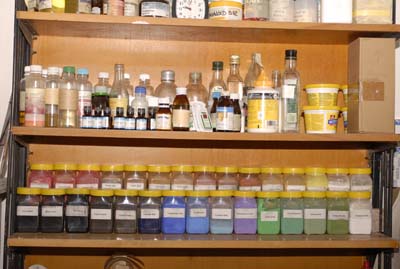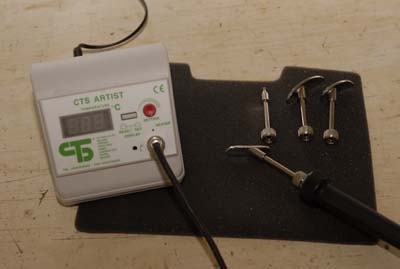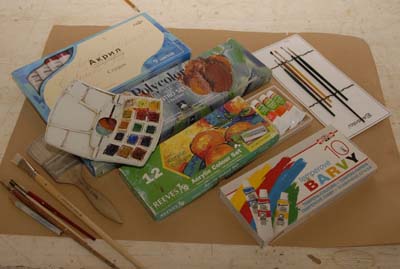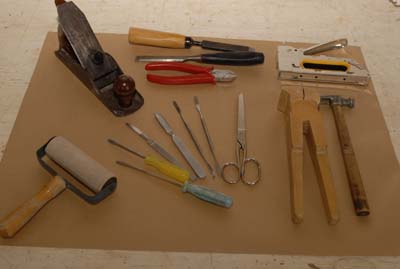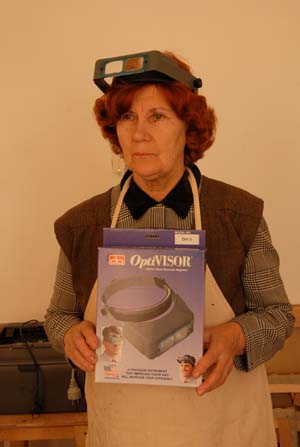A restoration section is one of the key sections of the museum responsible for proper maintaining and conservation of the works of art. That’s why the museum administration pays much attention to the development and proper functioning of this section, considering it as one of its priorities. Thus, during the last 20 years unprecedented efforts were made by the museum in order to create its own restoration section.
The museum administration persistently organized various trainings and extension courses for the museum restorers. It acquires for them different restoration materials, chemical and technical means. The museum restorers are provided with spacious and light rooms, each of them has his own working place with big tables. The museum has a number of specialists including restorers in painting, applied art, archaeology and in wood.
Due to good relations between the museum director and the diplomatic staff of friendly countries, accredited in Uzbekistan, they render much assistance to the museum and its restoration section in particular. For example, the French Embassy several times sent their specialists for training our restorers; the German also did so, and besides that, it sent them different restoration materials, including glues, optical instruments, knives, temperature resistant films in rolls, special Japanese paper in packs, which are indispensable for restoration works.
The financial means granted by the «Museum Friends» organization were used for purchasing canvases, prints, transparent paper, wood as well computers, high- quality digital camera ( a gift from brother and sister ter Horst from Holland) and multi-coloured printer with scanner.
A board Chairman of the «Museum Friends» Mr. David Pearce who helped us much during his work as a chief of the World Bank office in Uzbekistan, continues his support of the museum in restoration programmes, although now for many years he lives in his native country.
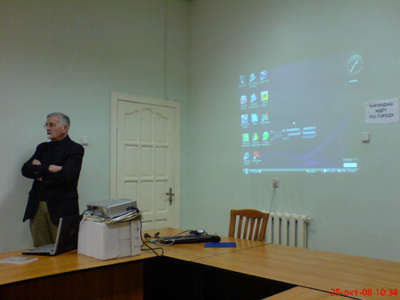
Mr. Pearce is preparing to show the film about our museum
Seminars and trainings:
From February 24 to March 25, 1989, in the Savitsky State Museum of Art in Nukus the 1st` All Union training of restorers was held under the guidance of the All Union Scientific Research Institute of Restoration (AUSRIR) specialists Yusif Gajikasimov and V.I. Shulgin. The restorers from different regions of the Soviet Union took part in this training, including Rozhkov A.I. (Leningrad), Boychenko S.A. (Sochi), Toporkov V.N. (Sverdlovsk), Cheryomushkina E.N. (Dagestan), Nevolin A.Y., Lukashevich V.A., Lipskiy A.N. (Belorussia). The participants from the Savitsky museum were chiefs of the restoration section A. Shpade and restorers Bayramova Ramilya Matchanov Rashid.
In 1991 D. Samekeev held his degree of AUSRIR in ceramics restoration, and in 1994, he held his degree of the Geological Centre (Tashkent) in restoration of metal items.
In June, 1996, a well –known Pierre Chevalier organized master-class for the museum staff in textile conservation and its treatment with counter-moth and other insecticides, which was held at the exposition and store-rooms of the applied art section. He showed in practice how and with what preparations to get rid of insects and to prevent their penetration into the store-rooms and show-cases. The carpet articles were put refrigerators for 3 days in order to kill the harmful insects with a frost. Mr. Chevalier also technically supported the museum and gave it a vacuum- cleaner, two sprayers as well as various insecticides. Moreover, one of the Louvre restorers taught D. Samekeev how to glue the ceramic articles.
Participants of these master-classes were Babanazarova M.M, the museum director, chief of the applied art section Pirnazarova Aygul, and restorers A. Shpade, Z. Gasanova, R. Matchanov and D. Samekeev.
In May, 2002, the applied art section staffs Pirnazarova Aygul, and Matjanova Arzayim were trained in textile conservation by the St. Petersburg restorers Tsareva E.G. and her colleagues.
In March, 2004, the members of international organization RSF («Restorers without Frontiers») Pavlos Politis and Ansel Mullins, Laurence Durand and Dalia Mees selected 56 art works for their joint restoration together with the Savitsky museum restorers. These selected works were taken photograph, documented and described.
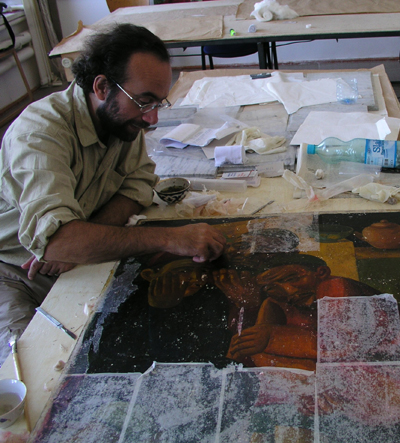
The project chief Pavlos Politis from Greece
In spring, 2005, the members of RSF Borislava Nacheva, Yuanna Kancheva and Avrora Ortega de Torre began to restore the selected works. In the course of their work the museum restorers A. Shpade, Z. Gasanova, R. Matchanov were trained under their guidance for 4 months. RSF members left for the restoration section modern materials (glues, mini-irons, temperature resistant films and different paints). Before RSF arrival the museum used techniques developed by the Grabar Centre (Moscow) which is based on organic substances such as a fish-glue, whose preparing is very hard and takes several days. Arrival of RSF members and training of our restorers under their guidance were very useful in time. In the course of their training our restorers learnt new approaches of modern restoration. Due to use of new techniques the restoration process became faster and better. They began to use different synthetic glues based on acrylic polymers. Such glues have a high adhesiveness capacity for canvases, they are durable, rapidly get dry and are not sensitive to temperature changes that is very important for the already restored works. But the fish-glue continues to be priority in restoration of paintings because it is reversible substance and can be removed easily and to be glued again. It is very difficult to answer the question “Which techniques are better?” Each restorer makes acceptable choice himself and different restorers have different opinions.
In summer, 2005, another group of RSF members came, including Anna Manyakovska (Poland), Ilya Asenov and Sasho Minchev (Bulgaria).
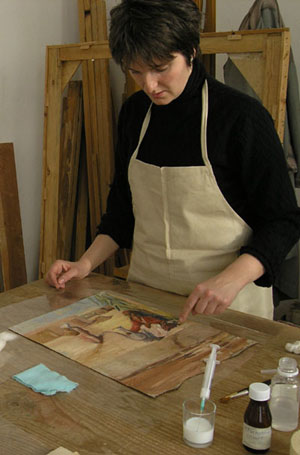
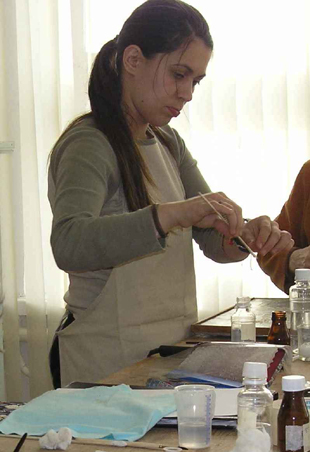
Bulgarian restorers Yuanna Kancheva (from left) and Borislava Nacheva (from right)
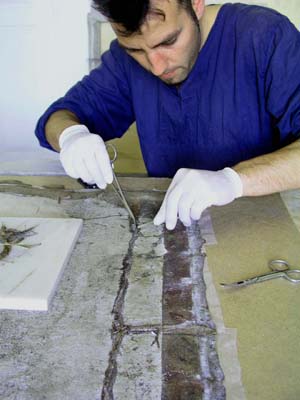
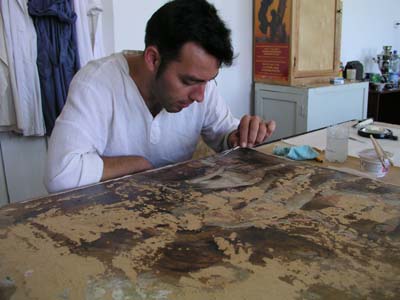
Restorer from Bulgaria Ilya Asenov
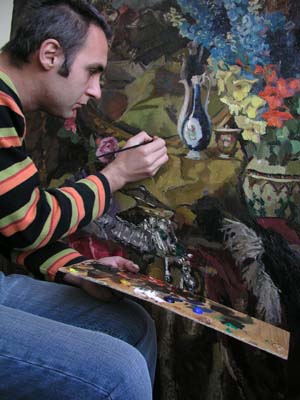
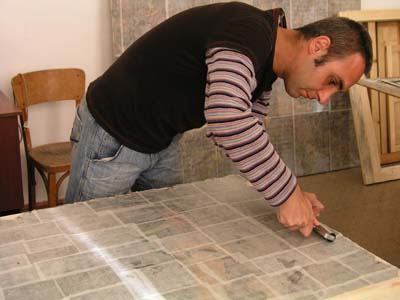
Restorer from Bulgaria Sasho Minchev
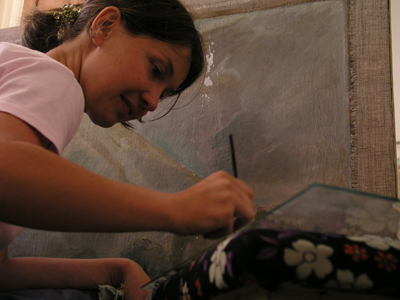
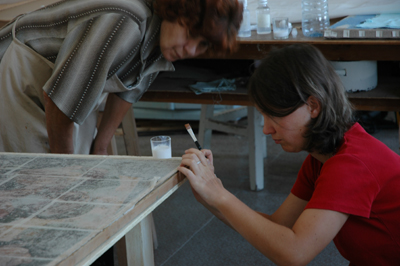
Polish restorer A. Manyakovska
They went on training of the museum restorers, simultaneously restoring the works of art. Any new restorer coming to our museum is a good chance to enrich knowledge’s of our restorers and to exchange their accumulated experiences. So, RSF members’ visit was very useful for us. Among a number of restored Savitsky’s paintings two of them (restored by Asenov and Minchev) deserve to be mentioned. These still-lifes suffered from fire in his flat many years ago. Both were of large dimensions. Each of them lost huge parts of their surfaces which were burnt out. It was interesting to observe RSF members’ work. Helping them in restoration process, we received a new experience, reinforced with practice that made us more self-reliant.
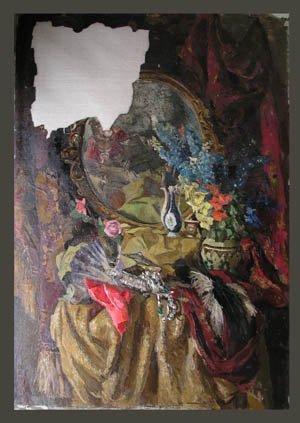
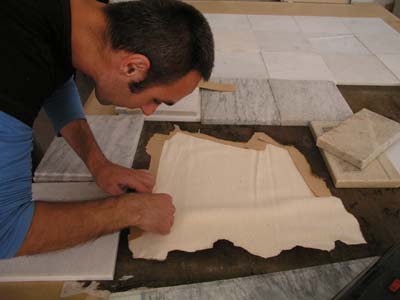
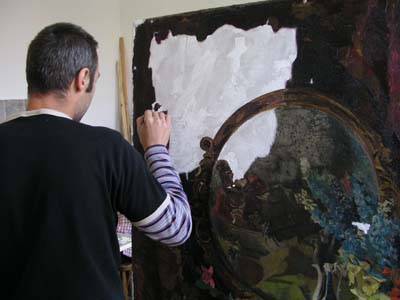
Restoration of Savitsky’s work “Still-life”. Restorer S. Minchev
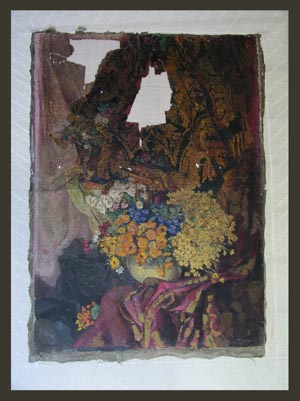
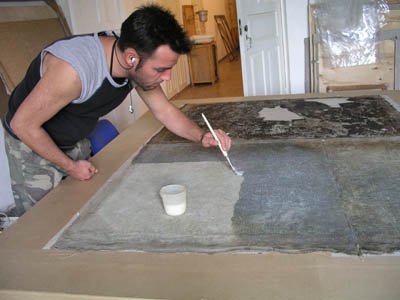
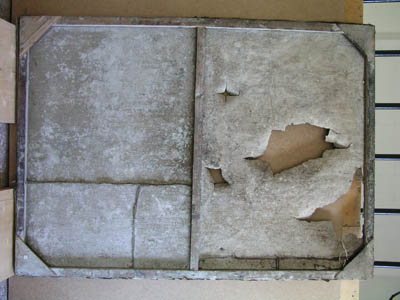
Restoration of Savitsky’s work “Still-life”. Restorer I. Asenov
In autumn, 2008, the knowledge’s received from RSF members were additionally improved with another restorer from France Geraldine Fray, who organized on-site restoration workshop for the museum restorers and nowadays still continues to consult them annually.
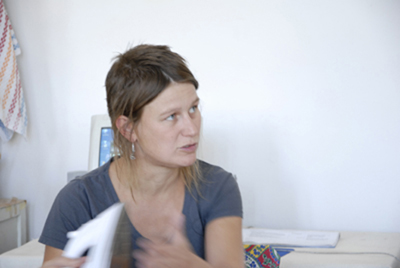
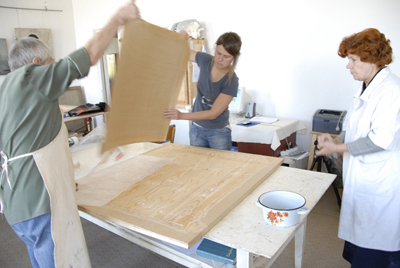
French restore G. Frea
In September, 2009, a painting restorer from Germany Corinne Rutenberg spent 1 month in the museum, training the museum restorers with the Financial assistance of the German Embassy, and German SES organization.
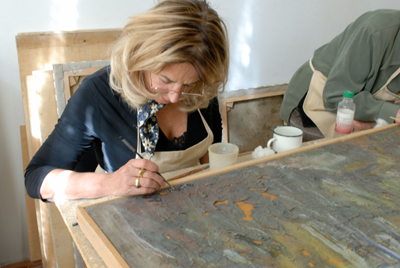
1st from left. German restorer C. Rutenberg
Together with our restorers she jointly restored 9 works. She gave them consultations concerning the problematic works, including their discussion of the Utegenov’s work “In a native village”. In her opinion, that work was of particular complexity for restoration and its treatment had to be done carefully, and the best decision would be to postpone its restoration. This work had a harmful damage caused by penetration of water and resulted in peeling of its paint layer and shelling of its surface.

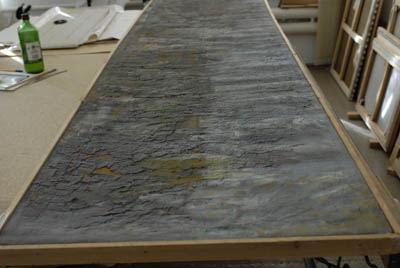
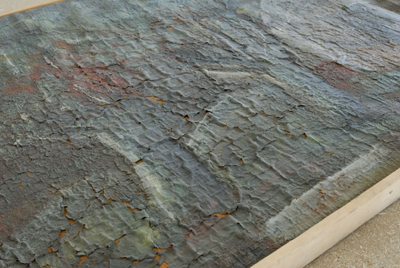
Work by Utegenov A. “In a native village”
But it was not possible to keep the work in such state, because any time it could be accidentally destroyed from any mechanical action. The museum director approved a decision of the Restoration Council to reinforce the work’s paint layer, which later was done by the museum restorers. In a case of success it would be the museum’s own know-how.
In November, 2009, restorer R. Matchanov took part in a master-class organized by the French Embassy in Tashkent. The master-class was conducted by the French restorers Geraldine Fray and Cecil Brinkuer and among its participants were museum restorers from Tashkent, the Republic of Karakalpakstan and other provinces of Uzbekistan.
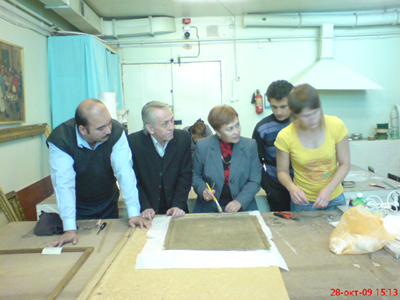
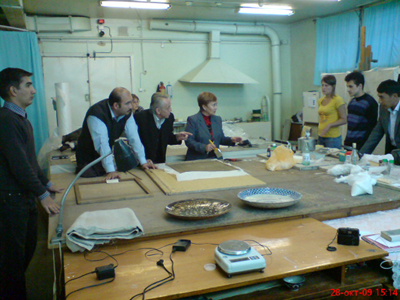
In a yellow T-shirt is the French restorer Geraldine Fray with her workshop participants
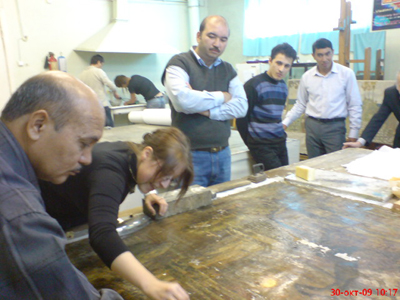

French restorer Cecil Brinkuer with his workshop participants
Restoration of painting:
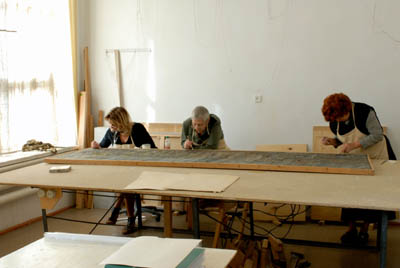
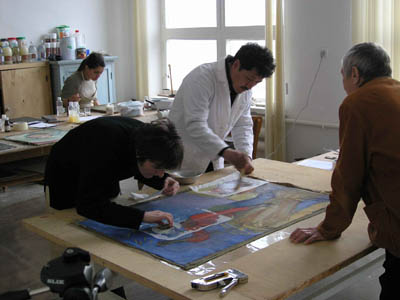
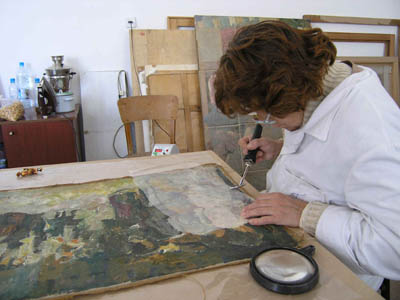
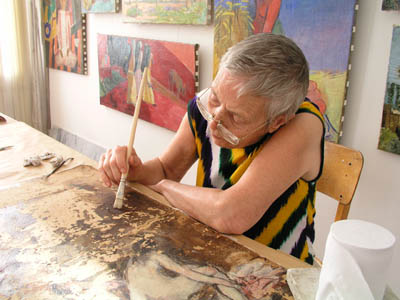
Restorers Z. Gasanova (from left) and A. Shpade (from right)
Restorers of the archaeological section:
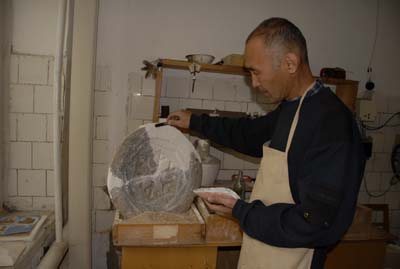
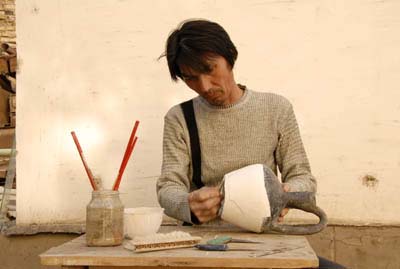 Restorers D. Samekeev and M. Abdullayev
Restorers D. Samekeev and M. Abdullayev
Restorers of the applied art section:
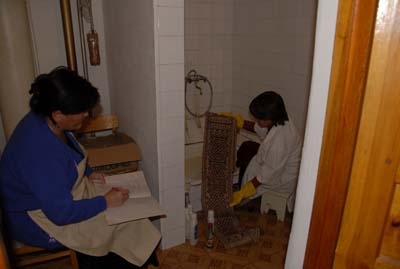
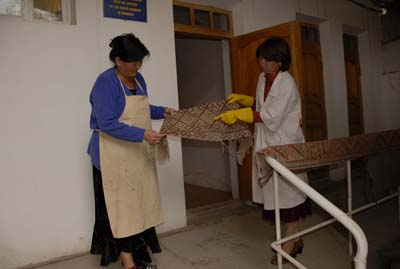
The applied art section staff during conservation of carpet textiles
Members of the Restoration Council:
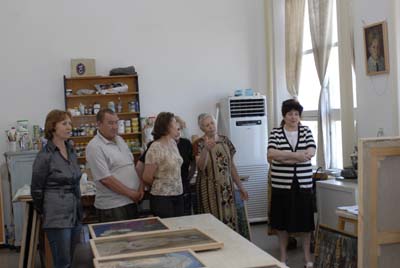
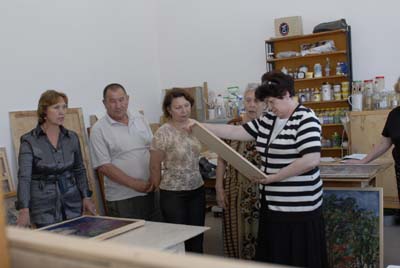
Some tools and objects used in restoration:
